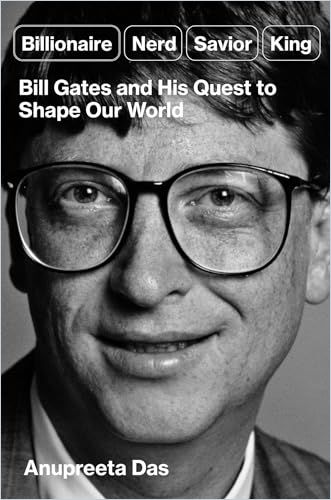Former New York Times finance editor Anupreeta Das provides a complex portrait of a titan who incarnates his era.

From Brutal Competitor to Philanthropist
As Microsoft’s CEO, Bill Gates mercilessly dispatched the slightest threat to its dominance. Today, he’s giving away his fortune as the Gates Foundation fights disease, hunger, and poverty worldwide.
Genius Tech Nerd
Microsoft co-founder Bill Gates is the perfect incarnation of the socially awkward technology whiz kid who becomes a billionaire and changes the world. Today, Gates is emulating 19th-century tycoons – having transformed himself from an empire builder to a philanthropist.
Plutocrats…are our shadow rulers – private actors shielded by their wealth – and we are unwitting accomplices to the perpetuation of this system.Anupreeta Das
In the 1970s, Paul Allen learned that the manufacturers of the MITS-Altair microcomputer were seeking a programming language for their device. He told his friend Bill Gates, who called the company from his Harvard dorm room, claiming he and Allen had almost completed writing a BASIC product that fit the bill. When the Altair’s manufacturer set a meeting, Gates and Allen hastily wrote the code.
The pair, who dubbed their new product “Micro-Soft,” eventually moved to Seattle. They thought desktop computers would become ubiquitous, and Gates envisioned software as an “intellectual property” he could monetize.
Gates was a rock star in the business world, inviting the kind of adoration reserved for Hollywood celebrities and sports stars.
After striking a deal to build an operating system for IBM’s personal computer, Microsoft purchased a disk operating system from Seattle Computer Products, named it MS-DOS, and licensed it to IBM. The licensing agreement Gates struck with IBM allowed Microsoft to license MS-DOS to other computer makers. The licenses Microsoft sold to manufacturers earned billions of dollars over the decades.
In 1986, Microsoft launched its initial public offering, and within a decade, Gates became the richest man in America.
Market Dominance
Gates was determined to dominate the software industry by constantly innovating and vanquishing or absorbing his competitors. He became famous for eschewing vacations, holding meetings that lasted for hours without breaks, and castigating employees who fell short of his expectations.
Microsoft built its empire around Windows software, which, by the mid-1990s, ran nine out of 10 computers. Microsoft often built its own version of its rivals’ products, and incorporated them into Windows.
Compassion was not part of the culture of Microsoft. (former Microsoft engineer Robbie Cape)
For example, many people used Netscape’s Navigator browser to access the “new” World Wide Web. Microsoft created its own browser, Explorer, and offered it as a part of Windows 95. This move hobbled Netscape’s access to the browser market. Microsoft also applied strong-arm tactics to drive other products from the software market, including Lotus 1-2-3 and WordPerfect.
In 1994, following a Federal Trade Commission investigation, Microsoft signed a consent decree agreeing to limit some of its business practices. In 1998, the US Department of Justice and 20 states filed an antitrust suit that accused Microsoft of abuse of monopoly power.
In the subsequent trial, Gates was arrogant and derisive during his three-day deposition. Former employees regard the trial as a major blow to Microsoft operations. In 2000, Gates resigned as chief executive.
The antitrust case led to a 2002 settlement that imposed restrictions and installed a special master to oversee operations for the next 10 years.
In 2014, new CEO Satya Nadella introduced a more cooperative corporate culture, refocusing the company on office productivity tools and cloud-based software.
The Gates Foundation
Gates and his [former] wife Melinda created the Bill and Melinda Gates Foundation with an initial bequest of about $22 billion. In 2006, Warren Buffett announced that most of his philanthropic funds would go to the Gates Foundation.
When the Foundation oversees a project, its team selects which nonprofits will receive grants and tracks their progress in meeting goals set in collaboration with the Foundation. The Foundation, which cultivates relationships with governments, institutions, countries, universities, and nonprofits, sustains alliances among these organizations and develops new linkages.
The Foundation vests in public health, emphasizing the role of vaccines. In collaboration with the World Health Organization, UNICEF, and the World Bank, it founded the Global Alliance for Vaccines and Immunization, which works with pharmaceutical companies to lower vaccine costs for poorer nations.
In 2010, Gates teamed with Buffett to launch the Giving Pledge, which calls on billionaires to vow publicly to donate at least half their fortunes to charitable causes, either while alive or as bequests. By 2023, more than 200 billionaires had signed on.
In 2001, the Gates family won the Carnegie Medal of Philanthropy. In 2005, Time magazine named Bill and Melinda Gates and the rock star Bono its Persons of the Year to honor their philanthropic efforts.
Married since 1994, Bill and Melinda Gates divorced in 2021, amid rumors of Bill’s infidelities, including an affair with a Microsoft employee.She has continued substantial private philanthropy.
Abundant Billionaires
After the 2008 financial crisis of 2008, US households’ median incomes fell for four years in a row. Between 2010 and 2020, inflation-adjusted median income grew about 15%. During the same decade, the number of billionaires in the United States increased from 404 to 614, and their combined wealth more than doubled, from $1.4 trillion to $2.9 trillion. During the COVID-19 pandemic — from March 2020 to November 2022 — the combined wealth of US billionaires increased by around $2.7 billion per day.
Billionaires often appear to be able to bend convention to fit their peculiar needs, feed their obsessions, act on their whims, and impose their preferences – in ways big and small, splashy and covert, dangerous and benign.Anupreeta Das
Even billionaires themselves are now questioning their privileged status. For example, Buffett called for raising the tax rates on investments. Gates, who has supported estate taxes, says he would be willing to pay $10 billion more in taxes.
Insightful Surprises
Former New York Times finance editor Anupreeta Das offers a multifaceted portrait of this complex tech titan and explores Gates’ brutal business tactics, dedication to philanthropy, and evolving public image. Das considers the implications of billionaires’ influence on culture and politics and analyzes society’s conflicting attitudes toward that influence. Gates provides ample fodder for sensationalism – for example, take his friendship with the late disgraced, convicted sex offender Jeffrey Epstein – but Das understands that the most illuminating aspect of Gates’ life is his shift from ferocious competitor to benevolent philanthropist. As much as you may think you know of Gates’ life, and of his arc from one extreme of capitalism to the other, Das provides insightful surprises.











